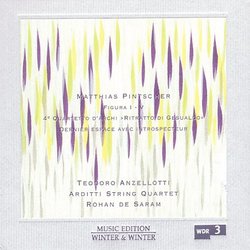| All Artists: Matthias Pintscher Title: Matthias Pintscher: Figura I-V; 4 Qaurtetto d'archi "Ritratto di Gesualdo"; Dernier espace avec introspecteur Members Wishing: 0 Total Copies: 0 Label: Winter & Winter Release Date: 4/6/2004 Genre: Classical Styles: Chamber Music, Historical Periods, Classical (c.1770-1830) Number of Discs: 1 SwapaCD Credits: 1 UPC: 025091009725 |
Search - Matthias Pintscher :: Matthias Pintscher: Figura I-V; 4 Qaurtetto d'archi "Ritratto di Gesualdo"; Dernier espace avec introspecteur
 | Matthias Pintscher Matthias Pintscher: Figura I-V; 4 Qaurtetto d'archi "Ritratto di Gesualdo"; Dernier espace avec introspecteur Genre: Classical |
Larger Image |
CD Details |
CD ReviewsScintillating Sound Jeremy Glazier | Columbus, OH | 07/27/2004 (5 out of 5 stars) "2004 marks the 30th Anniversary of the Arditti String Quartet, which once again demonstrates its commitment to the advancement of New Music--this time by the young German Matthias Pintscher (b. 1971).
For the discerning listener of New Music, this disc offers both substance and style. Winter & Winter's packaging is exquisite and attractive (although I haven't figured out why the booklet offers nine blank pages followed by two pages of track and publisher information, when brief liner notes or at least some biographical information--especially in the case of a young composer--would be helpful not only in giving context to the works performed but also in establishing a base listenership). The selection of pieces is interesting: Figura I-V is a rare (perhaps unique) "accordion quintet" whose sound is haunted by the ghost of Xenakis. The accordion participates only in two movements--with the quartet in I and by itself in III--and the rarified sound it contributes to the piece is unlike anything you're likely to have heard: at times it so blends into the sound of the strings that it's practically transparent, then at other times making itself known in sharp relief. The music is exquisite and virtuosic, as Teodoro Anzellotti manipulates the accordion's sounds to morph into all kinds of noise (at one point it seems to make the sound of fluttering bird wings--a sound that is both distressing and fascinating). Pintscher's Fourth Quartet, "Ritratto di Gesualdo," is (to make perhaps useless comparisons) reminiscent of both Scelsi and Lachenmann. Like all good music, from any period, this piece is constantly surprising, and repeated listening reveals ever greater depths and insight. Though it is never mechanical or machinistic, the brief intrusion of a human voice just before the end breaths passion and clarity into the work, bringing into focus the human element in both the composition and the performance. The third and final piece on the disc is a piece written ten years ago for accordion and cello, "Dernier Espace avec Introspecteur." The piece is of a similar sound-world as Figura I-V, but here the duel is given free rein to develop over one continuous movement of about 22 minutes. It's encouraging not only to hear excellent music by people of my generation (Pintscher is just four years older than I), but also to know that such music is being fostered and ferried into our world by masters like the Ardittis." |
